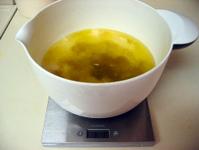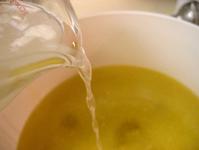Soap recipe and more information
I got several requests to share recipes and I thought I'd add a bit more in terms of general information on soap making. The biggest thing I want to say is that it's not a hard process and that the results are absolutely worth it.
(begin soap rant) If you've had dry skin every time you leave the shower and avoid soap for your face like the plague you need to try real soap. No, what you are using is most likely not soap. It's a detergent bar. Lever 2000, Irish Spring, Ivory, Dove and the rest of them - all detergent bars (notice how the packaging doesn't actually use the word "soap" anywhere? They can't, legally). What's the difference between real soap and a detergent bar? Real soap has high levels of glycerine that are produced as the lye and oils/fats chemically react or saponify and become soap. Detergent bars have that glycerin removed so it can be used in other products. This is why "soap" is so drying and harsh to skin. Oh, and if you're vegan you'll want to switch to real soap, since detergent bars pretty much all contain beef tallow as one of the main ingredients (it's cheap and readily available). Real soap, however, is very gentle and moisturizing. There is glycerin and a small amount of fats/oils remaining in the soap once it is finished and those ingredients moisturize and soothe skin. It's amazing what a difference there is once you try it. Real soap is gentle enough for the face, gentle enough for a baby's delicate skin. If you want to try soap without making your own, grab a bar of Dr. Bronner's soap, giggle a bit as you read the packaging, and give it a whirl. It's not my favorite soap by any means but it should be available at most health food stores, drug stores, and even many grocery stores. Just give real soap a try, OK? It's amazing stuff. (end soap rant)
Whew. Got that out of the way.
Now, you'd like to make soap? Here is my favorite recipe, sized to fit my soap molds. I use all vegetable oils, but you can use any fat or oil to make soap and there are many ardent fans of lard as a soaping ingredient (note: do not substitute oils for the ones I have listed without recalculating the amount of lye needed - the amount of lye listed is for this particular mix and amount of oils and fats only). This recipe produces a relatively hard bar that's creamy and full of suds when you use it and very gentle to the skin.
Basic Vegetable Oil Soap
2 ounces Castor Oil
7 ounces Coconut Oil
17 ounces Olive Oil
17 ounces Palm Oil
1 ounces Rice Bran Oil
Total Weight 44 ounces
14 ounces water
6.07 ounces lye (or 172 grams - I like to measure the lye using grams since it's a much more accurate measure of weight)
Optional things you can add in after trace:
3 Tablespoons essential oils
or
2 ounces fragrance oils (be sure fragrance oils are intended for soapmaking)
3 Tablespoons botanicals (any dry add-in such as herbs, ground tea leaves, seeds, ground oatmeal, etc.)
If you'd like to make up a different size batch, run it through a lye calculator, calculate for lye, then go to the bottom of the screen and change the amount to whatever you'd like. I wouldn't suggest going much smaller than 30 ounces or so as small amounts are tricky to measure properly and this is chemistry in action, so precise measurement is key.
A really basic vegetable soap recipe
17% coconut oil
42% palm oil
42% olive oil
lye needed for the amount of oils (again, use the lye calculator)
To figure out actual weights for the individual oils, plug in 17 oz. coconut oil, 42 oz. palm oil and 42 oz. olive oil into the calculator. Then resize the batch to whatever size you need. This is handy when you want to play around with the percentages of different oils/fats/butters, too.
Coconut, palm and olive oil are the vegetable oil triad - a mix of all three produces a well balanced, attractive soap. Coconut oil can be purchased in many grocery stores and pretty much all health food stores. Olive oil is easy, just get the cheapest you can get your hands on. Palm oil is tougher but can be found in restaurant supply stores. You can also order it online from many soap making companies. I'll list a bunch at the end of this entry. Lye can be purchased at some grocery stores (look for "Red Devil" drain cleaner) and in many hardware stores. Depending on where you live it might take a little bit of searching around to find some.
Even more information:
Kathy Miller's soap site - a great source of information on making soap. Tons of information here.
Walton Feed - another great starting place
The Soap Dish - one of my very favorite places to go to talk about all things soap related. There are some amazing people in this forum and a wealth of information available.
Majestic Mountain Sage - soap supplies and a great lye calculator
BrambleBerry - more soap supplies, great prices, great fragrance oils
SweetCakes - not the best prices, but awesome selection of fragrance oils
From Nature With Love - all the soap making supplies you could ever possibly want or need. Prices aren't the best, but you'll find literally everything here.
Camden Grey - essential oil mecca. Quality essential oils of every kind.
Essential Oil University - essential oils at truly incredible prices.










